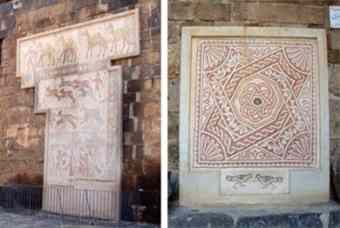Bosra Archaeological Museum embraces a lot of stone-made sculptures, mosaic paintings, inscriptions, clay potteries and metals dating back to different historical eras.
 Director of Bosra Antiquities Department Wafaa al-Aouda said that the Museum was built inside the halls of the 7th tower in 1214 AD, adding that it represents one of the Ayyubid Castle's towers which were built around Bosra Amphitheatre.
Director of Bosra Antiquities Department Wafaa al-Aouda said that the Museum was built inside the halls of the 7th tower in 1214 AD, adding that it represents one of the Ayyubid Castle's towers which were built around Bosra Amphitheatre.
She indicated that the Museum consists of two parts, the first of which is located in the 7th tower of the Castle, expanding over an area of 480 square meters while the second part is a 350 square-meter roofless museum that is located at the square to the northern side between the 10th and 11th towers.
The number of artefacts displayed in the Museum has reached 1117 pieces made of clay, stones and metals in addition to 759 glass pieces displayed in cabinets and 283 pieces in stores while 75 archaeological artefacts are displayed in the roofless museum.
391 clay pieces are displayed in Bosra Archaeological Museum including lanterns, potteries, bottles and hand-made grenades dating back to the Ayyubid era.
Al-Aouda indicated that the clay lanterns are the most important archaeological discoveries at Bosra Amphitheatre because they are one of the most ancient archaeological findings in the city which date back to the Iron and the Hellenistic Ages.
Some potteries and artefacts dating back to the Roman, Byzantine, Islamic and Early Bonze Ages are displayed in the Museum.
The Museum also includes 242 glass-made potteries dating back to the Roman and Byzantine eras, in addition to 273 metal jewelleries, household utensils, medical equipment and coins dating back to the Hellenistic, Roman and Byzantine eras.
150 stone-made sculptures and pillars dating back to different historical stages are displayed in the Museum, 50 statues of which are displayed in the roofless museum in addition to Greek, Latin, Nabatean and Islamic inscriptions.
Author: Ruaa al-Jazaeri | Source: Global Arab Network [August 04, 2010]